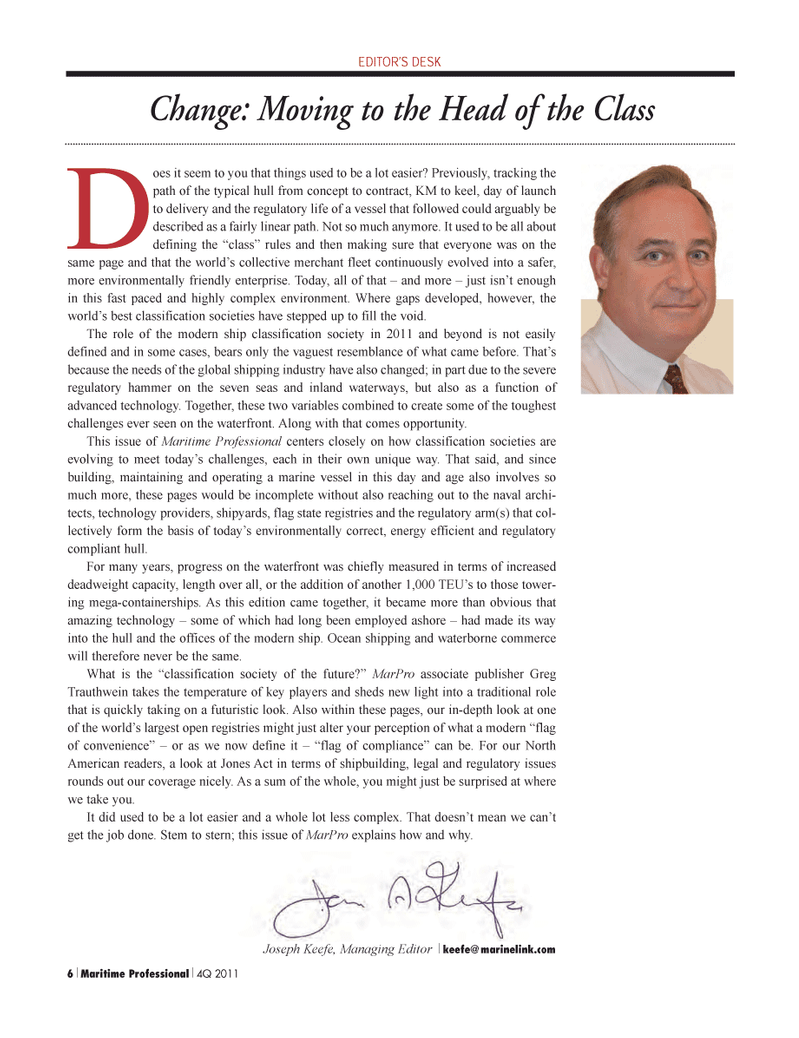
Page 6: of Maritime Logistics Professional Magazine (Q4 2011)
Classification
Read this page in Pdf, Flash or Html5 edition of Q4 2011 Maritime Logistics Professional Magazine
6 Maritime Professional 4Q 2011Change: Moving to the Head of the Class EDITOR?S DESK Does it seem to you that things used to be a lot easier? Previously, tracking the path of the typical hull from concept to contract, KM to keel, day of launch to delivery and the regulatory life of a vessel that followed could arguably be described as a fairly linear path. Not so much anymore. It used to be all about defining the ?class? rules and then making sure that everyone was on the same page and that the world?s collective merchant fleet continuously evolved into a safer, more environmentally friendly enterprise. Today, all of that ? and more ? just isn?t enough in this fast paced and highly complex environment. Where gaps developed, however, the world?s best classification societies have stepped up to fill the void. The role of the modern ship classification society in 2011 and beyond is not easily defined and in some cases, bears only the vaguest resemblance of what came before. That?s because the needs of the global shipping industry have also changed; in part due to the severe regulatory hammer on the seven seas and inland waterways, but also as a function of advanced technology. Together, these two variables combined to create some of the toughest challenges ever seen on the waterfront. Along with that comes opportunity. This issue of Maritime Professional centers closely on how classification societies are evolving to meet today?s challenges, each in their own unique way. That said, and since building, maintaining and operating a marine vessel in this day and age also involves so much more, these pages would be incomplete without also reaching out to the naval archi- tects, technology providers, shipyards, flag state registries and the regulatory arm(s) that col- lectively form the basis of today?s environmentally correct, energy efficient and regulatory compliant hull.For many years, progress on the waterfront was chiefly measured in terms of increased deadweight capacity, length over all, or the addition of another 1,000 TEU?s to those tower- ing mega-containerships. As this edition came together, it became more than obvious that amazing technology ? some of which had long been employed ashore ? had made its way into the hull and the offices of the modern ship. Ocean shipping and waterborne commerce will therefore never be the same. What is the ?classification society of the future?? MarPro associate publisher Greg Trauthwein takes the temperature of key players and sheds new light into a traditional role that is quickly taking on a futuristic look. Also within these pages, our in-depth look at one of the world?s largest open registries might just alter your perception of what a modern ?flag of convenience? ? or as we now define it ? ?flag of compliance? can be. For our North American readers, a look at Jones Act in terms of shipbuilding, legal and regulatory issues rounds out our coverage nicely. As a sum of the whole, you might just be surprised at where we take you. It did used to be a lot easier and a whole lot less complex. That doesn?t mean we can?t get the job done. Stem to stern; this issue of MarPro explains how and why. Joseph Keefe, Managing Editor keefe@ marinelink.comMP #4 (1-17):MP Layouts 11/8/2011 2:20 PM Page 6

 5
5

 7
7
